New World Supermarkets: Business Analysis
VerifiedAdded on 2020/04/13
|7
|1642
|258
AI Summary
This assignment analyzes New World Supermarkets, a chain of 140 stores across New Zealand. It examines their internal environment, including organizational structure, culture, and resource management, as well as their external environment, focusing on economic factors, legal regulations, and social trends. The analysis highlights their commitment to sustainability through energy-saving practices and addresses the impact of evolving consumer preferences and technological advancements on their business operations.
Contribute Materials
Your contribution can guide someone’s learning journey. Share your
documents today.
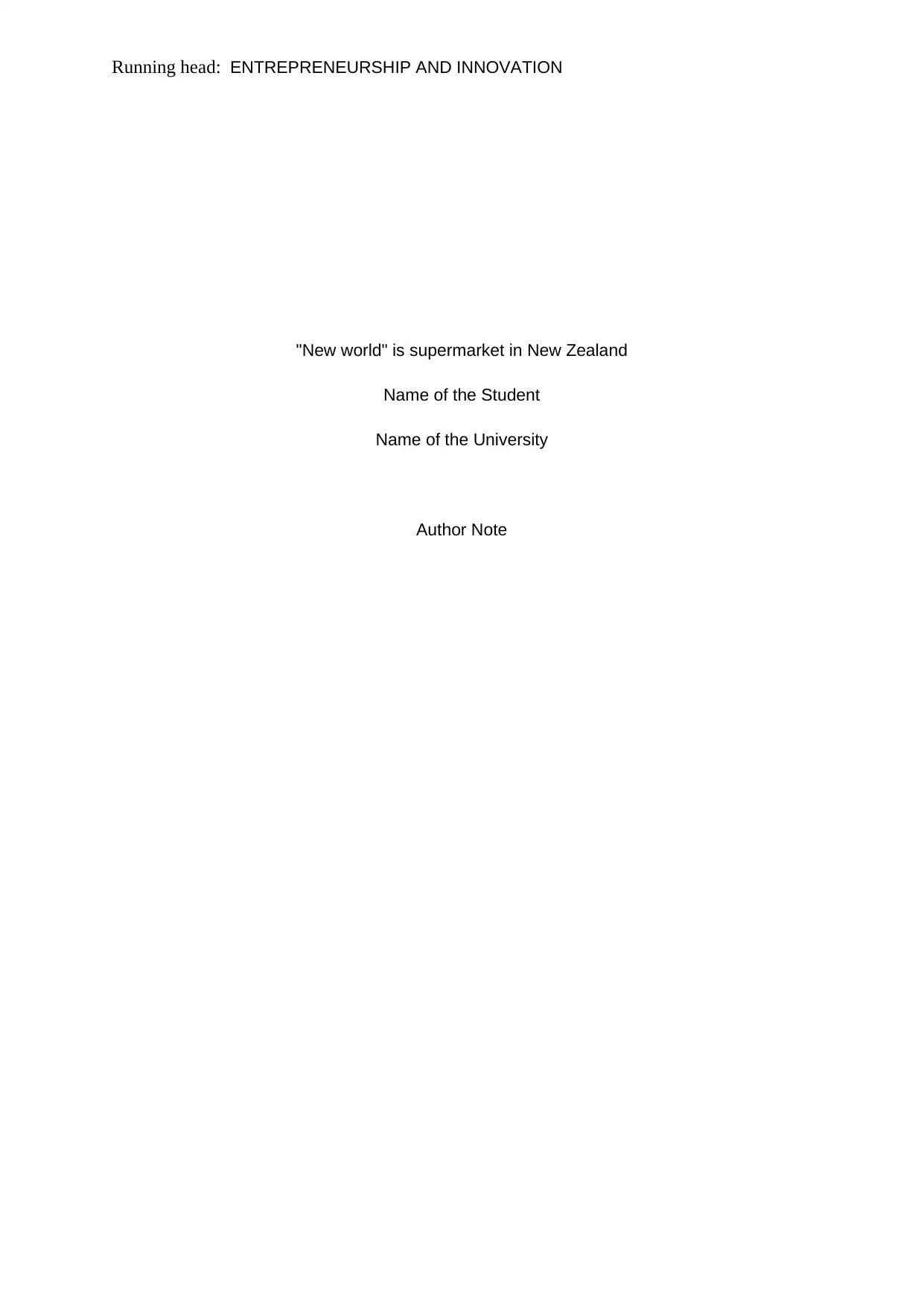
Running head: ENTREPRENEURSHIP AND INNOVATION
"New world" is supermarket in New Zealand
Name of the Student
Name of the University
Author Note
"New world" is supermarket in New Zealand
Name of the Student
Name of the University
Author Note
Secure Best Marks with AI Grader
Need help grading? Try our AI Grader for instant feedback on your assignments.
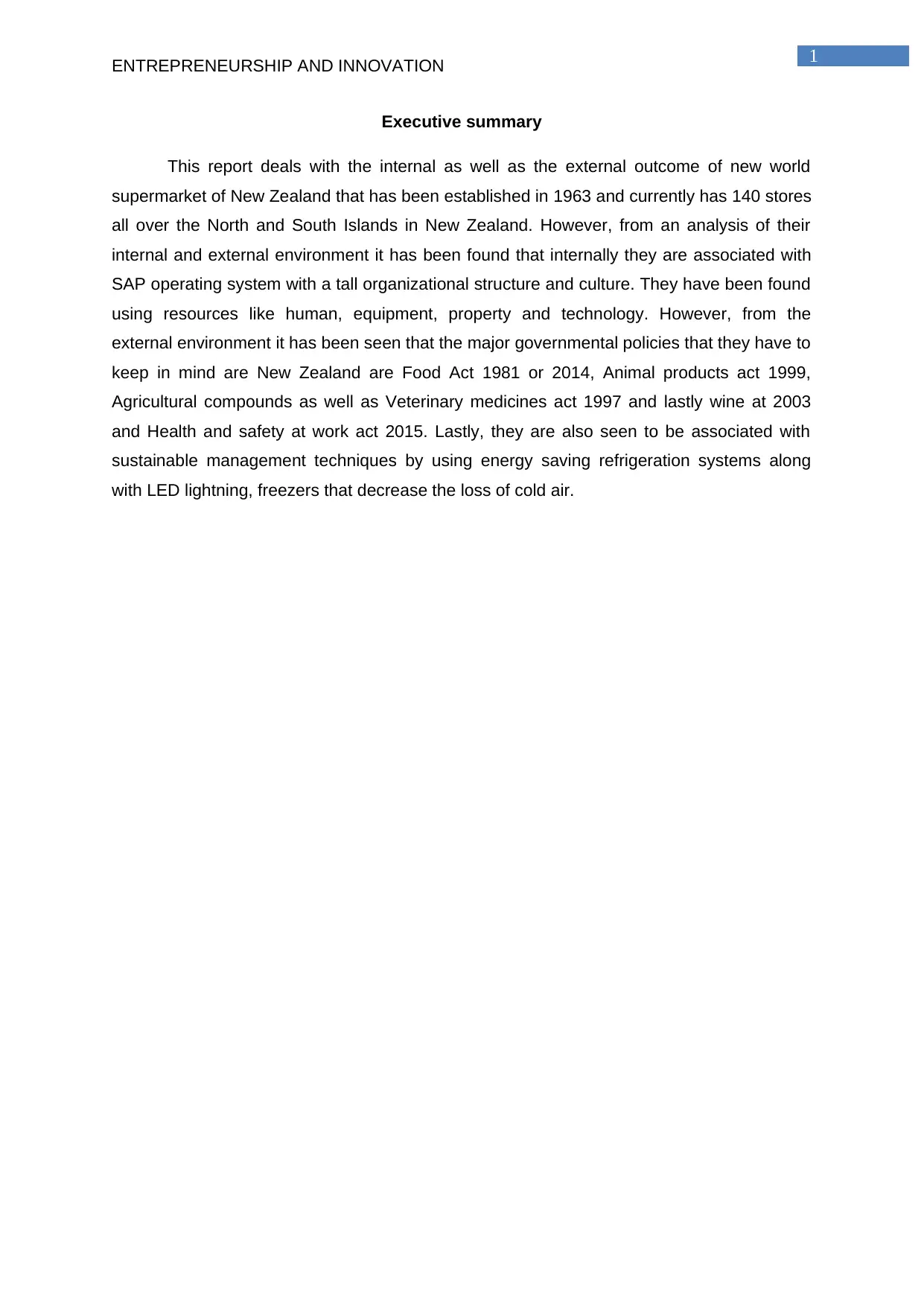
1ENTREPRENEURSHIP AND INNOVATION
Executive summary
This report deals with the internal as well as the external outcome of new world
supermarket of New Zealand that has been established in 1963 and currently has 140 stores
all over the North and South Islands in New Zealand. However, from an analysis of their
internal and external environment it has been found that internally they are associated with
SAP operating system with a tall organizational structure and culture. They have been found
using resources like human, equipment, property and technology. However, from the
external environment it has been seen that the major governmental policies that they have to
keep in mind are New Zealand are Food Act 1981 or 2014, Animal products act 1999,
Agricultural compounds as well as Veterinary medicines act 1997 and lastly wine at 2003
and Health and safety at work act 2015. Lastly, they are also seen to be associated with
sustainable management techniques by using energy saving refrigeration systems along
with LED lightning, freezers that decrease the loss of cold air.
Executive summary
This report deals with the internal as well as the external outcome of new world
supermarket of New Zealand that has been established in 1963 and currently has 140 stores
all over the North and South Islands in New Zealand. However, from an analysis of their
internal and external environment it has been found that internally they are associated with
SAP operating system with a tall organizational structure and culture. They have been found
using resources like human, equipment, property and technology. However, from the
external environment it has been seen that the major governmental policies that they have to
keep in mind are New Zealand are Food Act 1981 or 2014, Animal products act 1999,
Agricultural compounds as well as Veterinary medicines act 1997 and lastly wine at 2003
and Health and safety at work act 2015. Lastly, they are also seen to be associated with
sustainable management techniques by using energy saving refrigeration systems along
with LED lightning, freezers that decrease the loss of cold air.
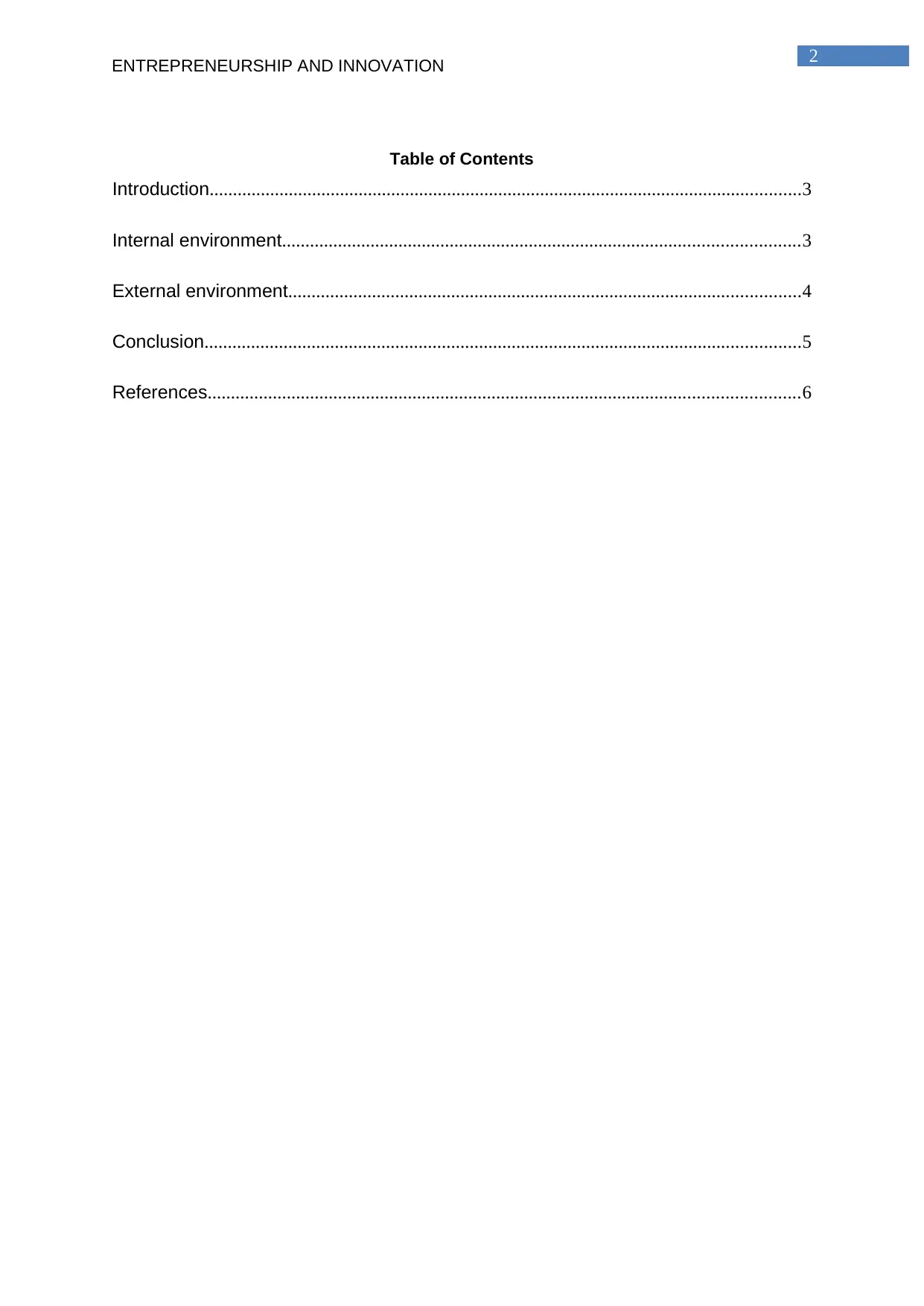
2ENTREPRENEURSHIP AND INNOVATION
Table of Contents
Introduction...............................................................................................................................3
Internal environment...............................................................................................................3
External environment..............................................................................................................4
Conclusion................................................................................................................................5
References...............................................................................................................................6
Table of Contents
Introduction...............................................................................................................................3
Internal environment...............................................................................................................3
External environment..............................................................................................................4
Conclusion................................................................................................................................5
References...............................................................................................................................6
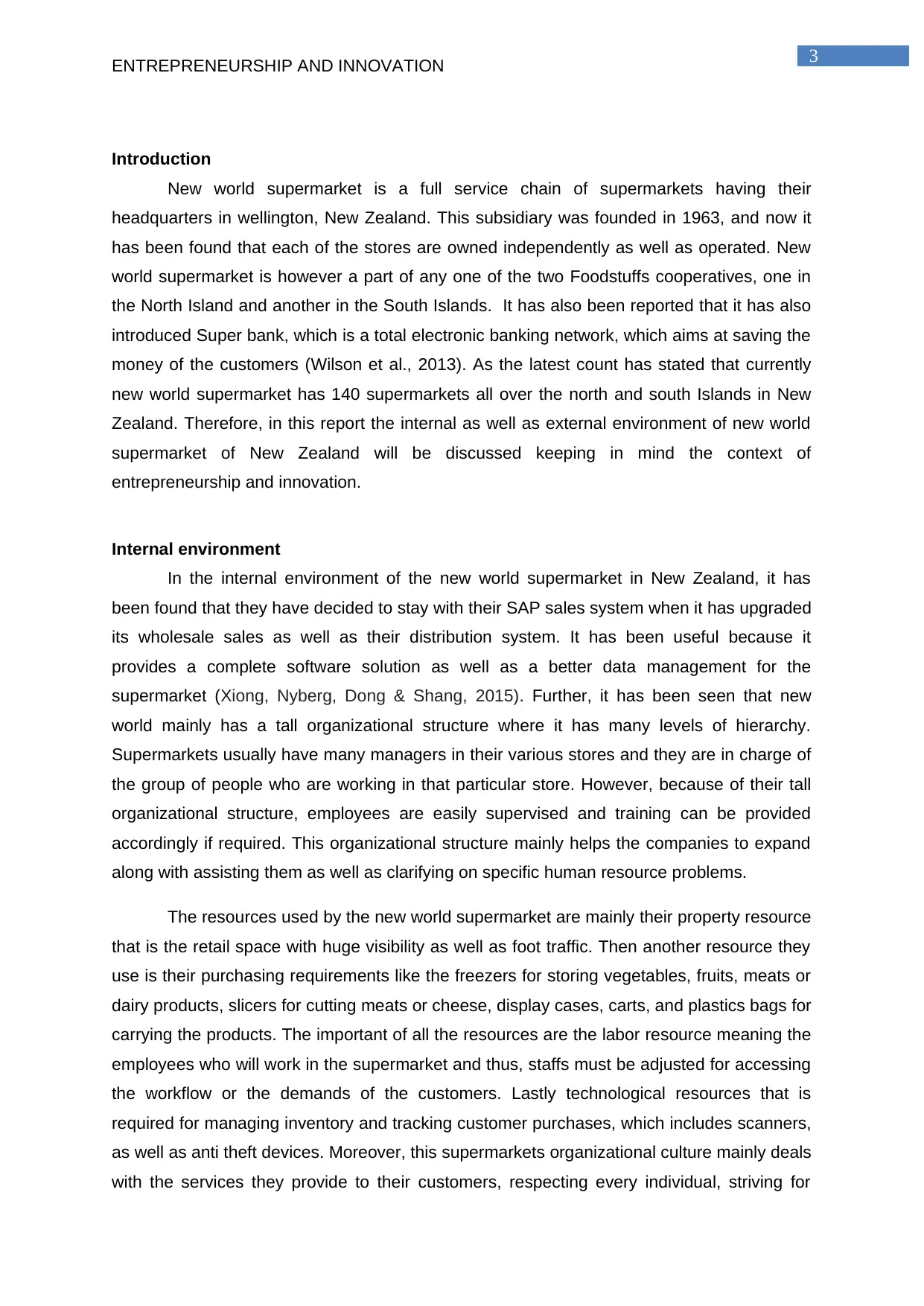
3ENTREPRENEURSHIP AND INNOVATION
Introduction
New world supermarket is a full service chain of supermarkets having their
headquarters in wellington, New Zealand. This subsidiary was founded in 1963, and now it
has been found that each of the stores are owned independently as well as operated. New
world supermarket is however a part of any one of the two Foodstuffs cooperatives, one in
the North Island and another in the South Islands. It has also been reported that it has also
introduced Super bank, which is a total electronic banking network, which aims at saving the
money of the customers (Wilson et al., 2013). As the latest count has stated that currently
new world supermarket has 140 supermarkets all over the north and south Islands in New
Zealand. Therefore, in this report the internal as well as external environment of new world
supermarket of New Zealand will be discussed keeping in mind the context of
entrepreneurship and innovation.
Internal environment
In the internal environment of the new world supermarket in New Zealand, it has
been found that they have decided to stay with their SAP sales system when it has upgraded
its wholesale sales as well as their distribution system. It has been useful because it
provides a complete software solution as well as a better data management for the
supermarket (Xiong, Nyberg, Dong & Shang, 2015). Further, it has been seen that new
world mainly has a tall organizational structure where it has many levels of hierarchy.
Supermarkets usually have many managers in their various stores and they are in charge of
the group of people who are working in that particular store. However, because of their tall
organizational structure, employees are easily supervised and training can be provided
accordingly if required. This organizational structure mainly helps the companies to expand
along with assisting them as well as clarifying on specific human resource problems.
The resources used by the new world supermarket are mainly their property resource
that is the retail space with huge visibility as well as foot traffic. Then another resource they
use is their purchasing requirements like the freezers for storing vegetables, fruits, meats or
dairy products, slicers for cutting meats or cheese, display cases, carts, and plastics bags for
carrying the products. The important of all the resources are the labor resource meaning the
employees who will work in the supermarket and thus, staffs must be adjusted for accessing
the workflow or the demands of the customers. Lastly technological resources that is
required for managing inventory and tracking customer purchases, which includes scanners,
as well as anti theft devices. Moreover, this supermarkets organizational culture mainly deals
with the services they provide to their customers, respecting every individual, striving for
Introduction
New world supermarket is a full service chain of supermarkets having their
headquarters in wellington, New Zealand. This subsidiary was founded in 1963, and now it
has been found that each of the stores are owned independently as well as operated. New
world supermarket is however a part of any one of the two Foodstuffs cooperatives, one in
the North Island and another in the South Islands. It has also been reported that it has also
introduced Super bank, which is a total electronic banking network, which aims at saving the
money of the customers (Wilson et al., 2013). As the latest count has stated that currently
new world supermarket has 140 supermarkets all over the north and south Islands in New
Zealand. Therefore, in this report the internal as well as external environment of new world
supermarket of New Zealand will be discussed keeping in mind the context of
entrepreneurship and innovation.
Internal environment
In the internal environment of the new world supermarket in New Zealand, it has
been found that they have decided to stay with their SAP sales system when it has upgraded
its wholesale sales as well as their distribution system. It has been useful because it
provides a complete software solution as well as a better data management for the
supermarket (Xiong, Nyberg, Dong & Shang, 2015). Further, it has been seen that new
world mainly has a tall organizational structure where it has many levels of hierarchy.
Supermarkets usually have many managers in their various stores and they are in charge of
the group of people who are working in that particular store. However, because of their tall
organizational structure, employees are easily supervised and training can be provided
accordingly if required. This organizational structure mainly helps the companies to expand
along with assisting them as well as clarifying on specific human resource problems.
The resources used by the new world supermarket are mainly their property resource
that is the retail space with huge visibility as well as foot traffic. Then another resource they
use is their purchasing requirements like the freezers for storing vegetables, fruits, meats or
dairy products, slicers for cutting meats or cheese, display cases, carts, and plastics bags for
carrying the products. The important of all the resources are the labor resource meaning the
employees who will work in the supermarket and thus, staffs must be adjusted for accessing
the workflow or the demands of the customers. Lastly technological resources that is
required for managing inventory and tracking customer purchases, which includes scanners,
as well as anti theft devices. Moreover, this supermarkets organizational culture mainly deals
with the services they provide to their customers, respecting every individual, striving for
Secure Best Marks with AI Grader
Need help grading? Try our AI Grader for instant feedback on your assignments.
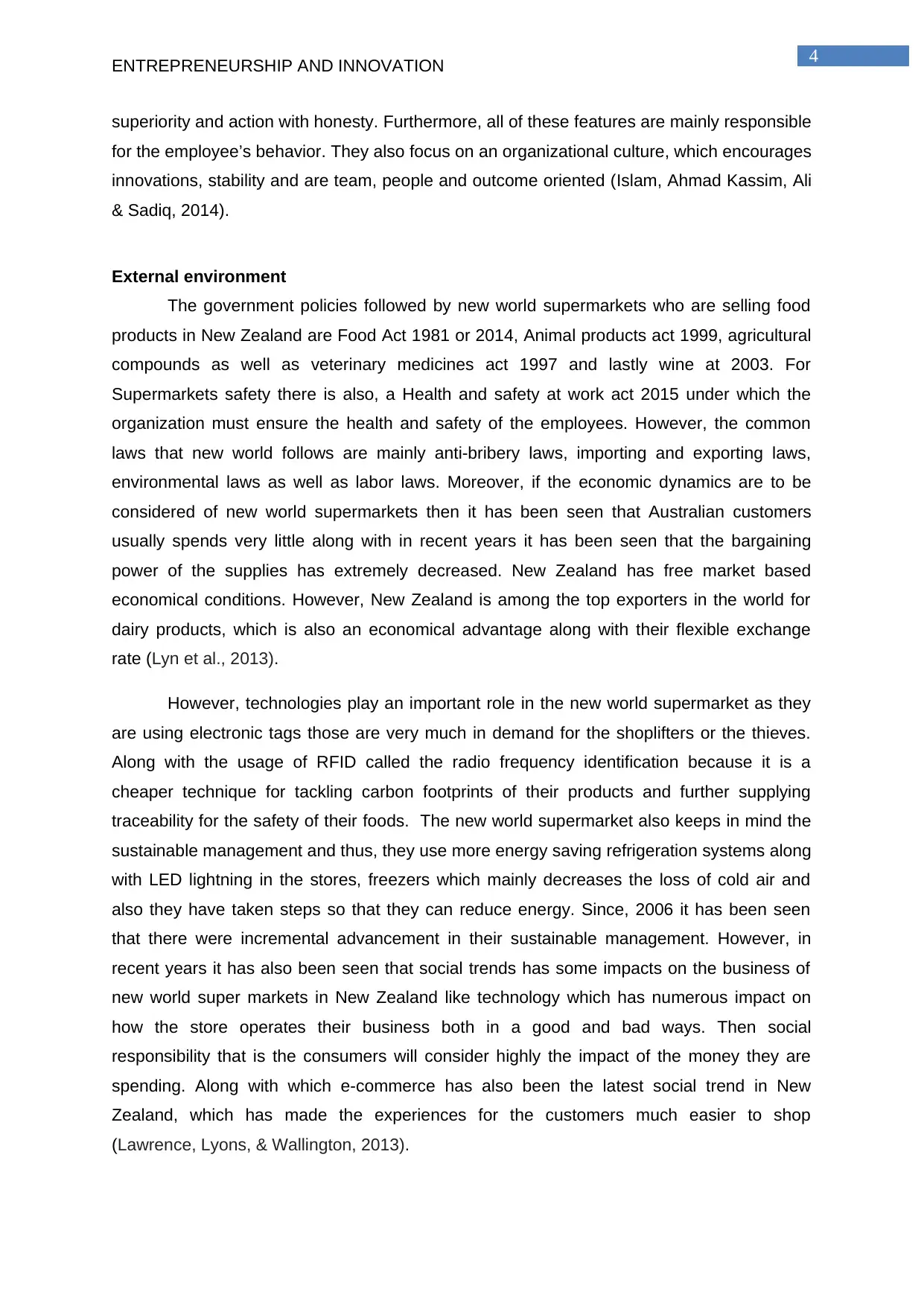
4ENTREPRENEURSHIP AND INNOVATION
superiority and action with honesty. Furthermore, all of these features are mainly responsible
for the employee’s behavior. They also focus on an organizational culture, which encourages
innovations, stability and are team, people and outcome oriented (Islam, Ahmad Kassim, Ali
& Sadiq, 2014).
External environment
The government policies followed by new world supermarkets who are selling food
products in New Zealand are Food Act 1981 or 2014, Animal products act 1999, agricultural
compounds as well as veterinary medicines act 1997 and lastly wine at 2003. For
Supermarkets safety there is also, a Health and safety at work act 2015 under which the
organization must ensure the health and safety of the employees. However, the common
laws that new world follows are mainly anti-bribery laws, importing and exporting laws,
environmental laws as well as labor laws. Moreover, if the economic dynamics are to be
considered of new world supermarkets then it has been seen that Australian customers
usually spends very little along with in recent years it has been seen that the bargaining
power of the supplies has extremely decreased. New Zealand has free market based
economical conditions. However, New Zealand is among the top exporters in the world for
dairy products, which is also an economical advantage along with their flexible exchange
rate (Lyn et al., 2013).
However, technologies play an important role in the new world supermarket as they
are using electronic tags those are very much in demand for the shoplifters or the thieves.
Along with the usage of RFID called the radio frequency identification because it is a
cheaper technique for tackling carbon footprints of their products and further supplying
traceability for the safety of their foods. The new world supermarket also keeps in mind the
sustainable management and thus, they use more energy saving refrigeration systems along
with LED lightning in the stores, freezers which mainly decreases the loss of cold air and
also they have taken steps so that they can reduce energy. Since, 2006 it has been seen
that there were incremental advancement in their sustainable management. However, in
recent years it has also been seen that social trends has some impacts on the business of
new world super markets in New Zealand like technology which has numerous impact on
how the store operates their business both in a good and bad ways. Then social
responsibility that is the consumers will consider highly the impact of the money they are
spending. Along with which e-commerce has also been the latest social trend in New
Zealand, which has made the experiences for the customers much easier to shop
(Lawrence, Lyons, & Wallington, 2013).
superiority and action with honesty. Furthermore, all of these features are mainly responsible
for the employee’s behavior. They also focus on an organizational culture, which encourages
innovations, stability and are team, people and outcome oriented (Islam, Ahmad Kassim, Ali
& Sadiq, 2014).
External environment
The government policies followed by new world supermarkets who are selling food
products in New Zealand are Food Act 1981 or 2014, Animal products act 1999, agricultural
compounds as well as veterinary medicines act 1997 and lastly wine at 2003. For
Supermarkets safety there is also, a Health and safety at work act 2015 under which the
organization must ensure the health and safety of the employees. However, the common
laws that new world follows are mainly anti-bribery laws, importing and exporting laws,
environmental laws as well as labor laws. Moreover, if the economic dynamics are to be
considered of new world supermarkets then it has been seen that Australian customers
usually spends very little along with in recent years it has been seen that the bargaining
power of the supplies has extremely decreased. New Zealand has free market based
economical conditions. However, New Zealand is among the top exporters in the world for
dairy products, which is also an economical advantage along with their flexible exchange
rate (Lyn et al., 2013).
However, technologies play an important role in the new world supermarket as they
are using electronic tags those are very much in demand for the shoplifters or the thieves.
Along with the usage of RFID called the radio frequency identification because it is a
cheaper technique for tackling carbon footprints of their products and further supplying
traceability for the safety of their foods. The new world supermarket also keeps in mind the
sustainable management and thus, they use more energy saving refrigeration systems along
with LED lightning in the stores, freezers which mainly decreases the loss of cold air and
also they have taken steps so that they can reduce energy. Since, 2006 it has been seen
that there were incremental advancement in their sustainable management. However, in
recent years it has also been seen that social trends has some impacts on the business of
new world super markets in New Zealand like technology which has numerous impact on
how the store operates their business both in a good and bad ways. Then social
responsibility that is the consumers will consider highly the impact of the money they are
spending. Along with which e-commerce has also been the latest social trend in New
Zealand, which has made the experiences for the customers much easier to shop
(Lawrence, Lyons, & Wallington, 2013).
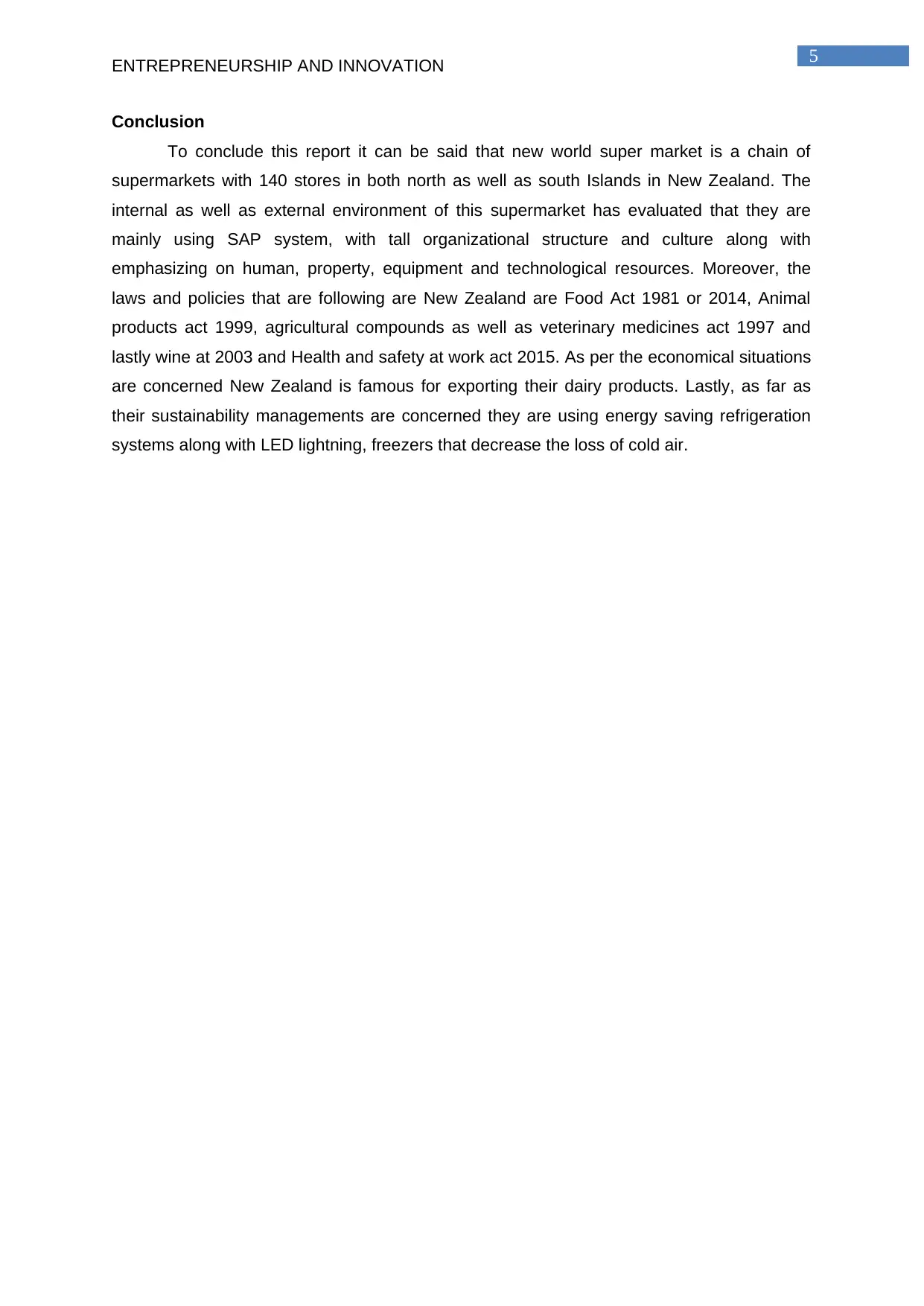
5ENTREPRENEURSHIP AND INNOVATION
Conclusion
To conclude this report it can be said that new world super market is a chain of
supermarkets with 140 stores in both north as well as south Islands in New Zealand. The
internal as well as external environment of this supermarket has evaluated that they are
mainly using SAP system, with tall organizational structure and culture along with
emphasizing on human, property, equipment and technological resources. Moreover, the
laws and policies that are following are New Zealand are Food Act 1981 or 2014, Animal
products act 1999, agricultural compounds as well as veterinary medicines act 1997 and
lastly wine at 2003 and Health and safety at work act 2015. As per the economical situations
are concerned New Zealand is famous for exporting their dairy products. Lastly, as far as
their sustainability managements are concerned they are using energy saving refrigeration
systems along with LED lightning, freezers that decrease the loss of cold air.
Conclusion
To conclude this report it can be said that new world super market is a chain of
supermarkets with 140 stores in both north as well as south Islands in New Zealand. The
internal as well as external environment of this supermarket has evaluated that they are
mainly using SAP system, with tall organizational structure and culture along with
emphasizing on human, property, equipment and technological resources. Moreover, the
laws and policies that are following are New Zealand are Food Act 1981 or 2014, Animal
products act 1999, agricultural compounds as well as veterinary medicines act 1997 and
lastly wine at 2003 and Health and safety at work act 2015. As per the economical situations
are concerned New Zealand is famous for exporting their dairy products. Lastly, as far as
their sustainability managements are concerned they are using energy saving refrigeration
systems along with LED lightning, freezers that decrease the loss of cold air.
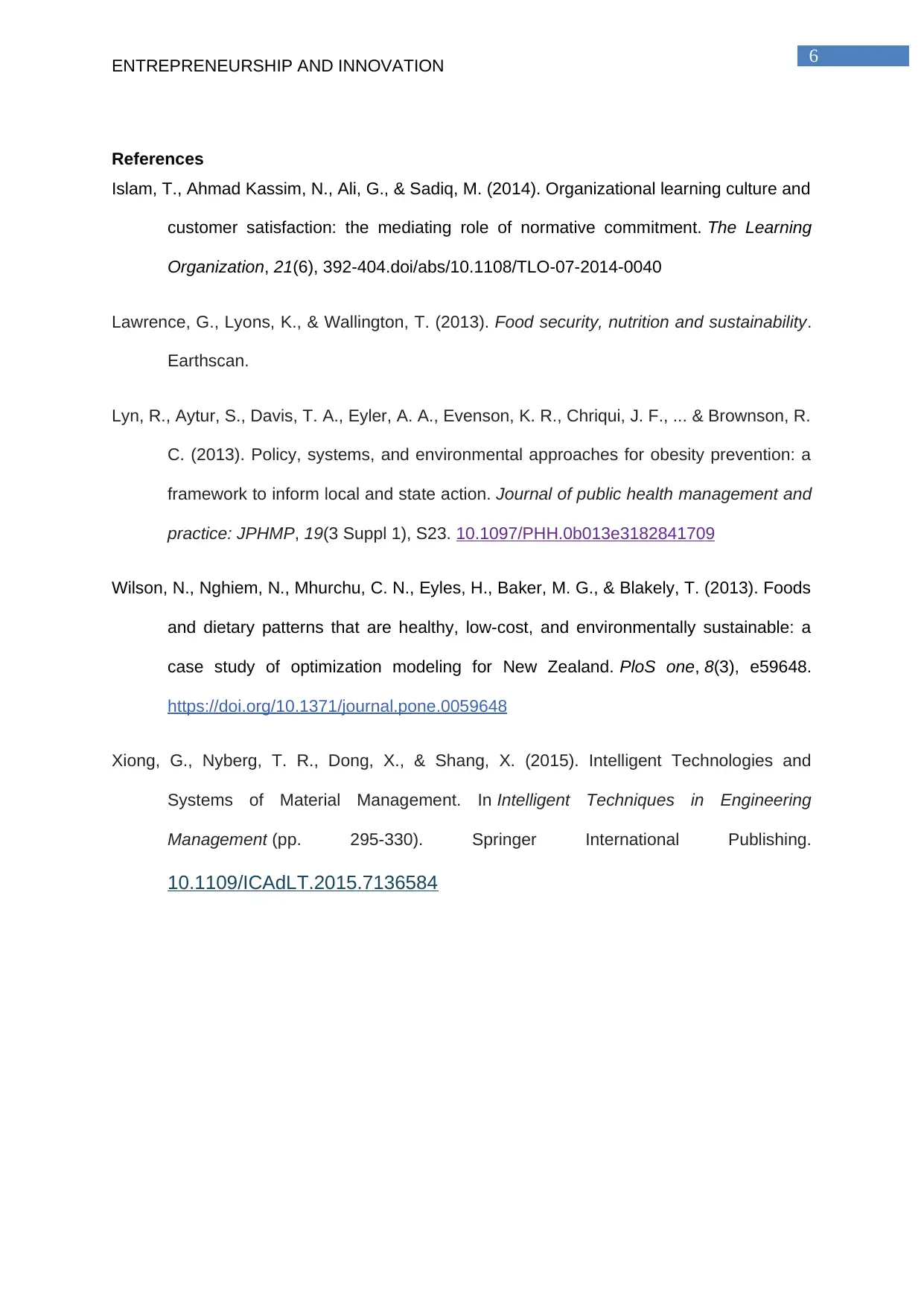
6ENTREPRENEURSHIP AND INNOVATION
References
Islam, T., Ahmad Kassim, N., Ali, G., & Sadiq, M. (2014). Organizational learning culture and
customer satisfaction: the mediating role of normative commitment. The Learning
Organization, 21(6), 392-404.doi/abs/10.1108/TLO-07-2014-0040
Lawrence, G., Lyons, K., & Wallington, T. (2013). Food security, nutrition and sustainability.
Earthscan.
Lyn, R., Aytur, S., Davis, T. A., Eyler, A. A., Evenson, K. R., Chriqui, J. F., ... & Brownson, R.
C. (2013). Policy, systems, and environmental approaches for obesity prevention: a
framework to inform local and state action. Journal of public health management and
practice: JPHMP, 19(3 Suppl 1), S23. 10.1097/PHH.0b013e3182841709
Wilson, N., Nghiem, N., Mhurchu, C. N., Eyles, H., Baker, M. G., & Blakely, T. (2013). Foods
and dietary patterns that are healthy, low-cost, and environmentally sustainable: a
case study of optimization modeling for New Zealand. PloS one, 8(3), e59648.
https://doi.org/10.1371/journal.pone.0059648
Xiong, G., Nyberg, T. R., Dong, X., & Shang, X. (2015). Intelligent Technologies and
Systems of Material Management. In Intelligent Techniques in Engineering
Management (pp. 295-330). Springer International Publishing.
10.1109/ICAdLT.2015.7136584
References
Islam, T., Ahmad Kassim, N., Ali, G., & Sadiq, M. (2014). Organizational learning culture and
customer satisfaction: the mediating role of normative commitment. The Learning
Organization, 21(6), 392-404.doi/abs/10.1108/TLO-07-2014-0040
Lawrence, G., Lyons, K., & Wallington, T. (2013). Food security, nutrition and sustainability.
Earthscan.
Lyn, R., Aytur, S., Davis, T. A., Eyler, A. A., Evenson, K. R., Chriqui, J. F., ... & Brownson, R.
C. (2013). Policy, systems, and environmental approaches for obesity prevention: a
framework to inform local and state action. Journal of public health management and
practice: JPHMP, 19(3 Suppl 1), S23. 10.1097/PHH.0b013e3182841709
Wilson, N., Nghiem, N., Mhurchu, C. N., Eyles, H., Baker, M. G., & Blakely, T. (2013). Foods
and dietary patterns that are healthy, low-cost, and environmentally sustainable: a
case study of optimization modeling for New Zealand. PloS one, 8(3), e59648.
https://doi.org/10.1371/journal.pone.0059648
Xiong, G., Nyberg, T. R., Dong, X., & Shang, X. (2015). Intelligent Technologies and
Systems of Material Management. In Intelligent Techniques in Engineering
Management (pp. 295-330). Springer International Publishing.
10.1109/ICAdLT.2015.7136584
1 out of 7
Related Documents
Your All-in-One AI-Powered Toolkit for Academic Success.
+13062052269
info@desklib.com
Available 24*7 on WhatsApp / Email
![[object Object]](/_next/static/media/star-bottom.7253800d.svg)
Unlock your academic potential
© 2024 | Zucol Services PVT LTD | All rights reserved.





